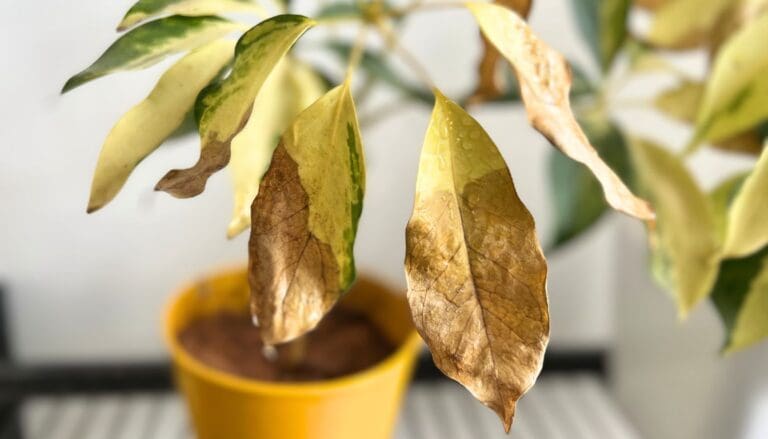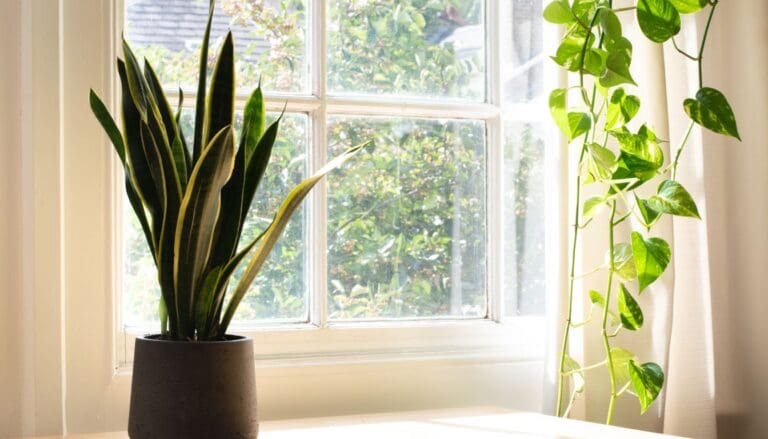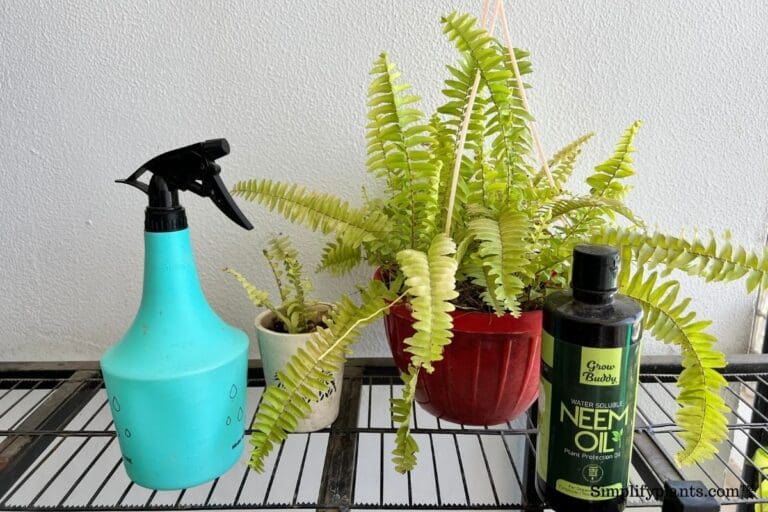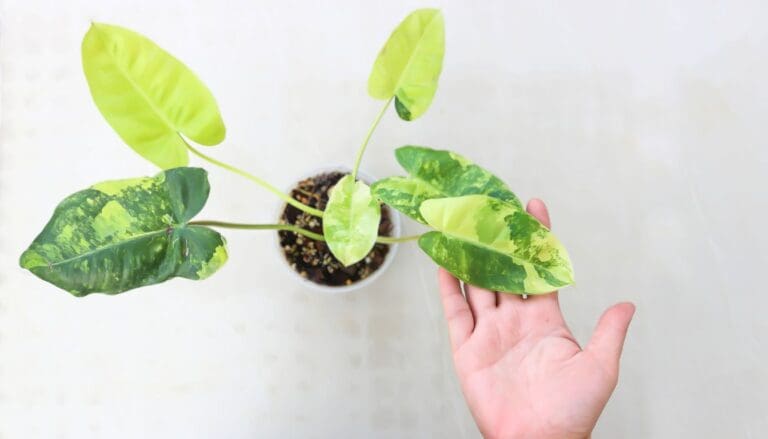How To Save An Overwatered Peace Lily? (Signs, Problems & Solution)
The peace lily is an easy-to-care-for indoor plant because it requires minimal care and blooms without much effort. But you need to remember some points while nurturing them. They are sensitive to issues like overwatering that can cause severe damage if not treated on time.
So, in this article, we shall learn how to save an overwatered peace lily plant.
Signs of an overwatered peace lily include drooping, leaves getting withered and discolored, brown tips, and root rot due to stagnation. To save the overwatered peace lily, move it to a shaded spot, prune damaged roots and foliage, and repot it to a new pot. Also, check the soil before watering.
The peace lily grows typically in tropical forests, and damp regions are not its place. That’s why it can survive on even a slightly less amount of water, rather than overwatering, which has adverse effects. If proper steps are not adapted to stop the overwatering, it may even kill your peace lily because its root system rots.
Start going through the article if you want to get acquainted with the signs of an overwatered peace lily and how you can fix your beloved plant. You will not miss a single thing of your plant care.
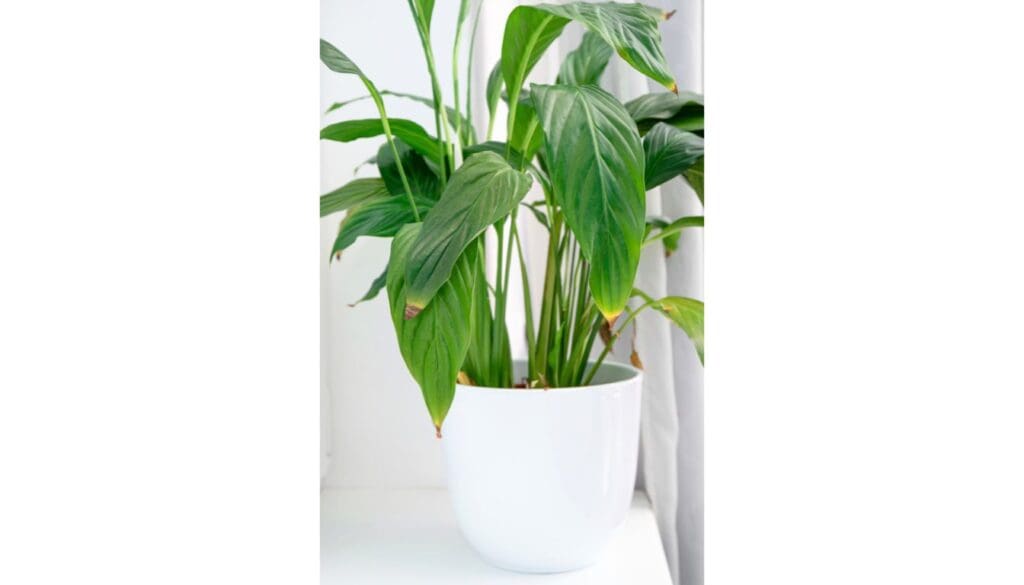
Please note: Simplify Plants is reader-supported. Some links in the post are affiliate links and I get a commission from purchases made through links in the post.
How to understand if the peace lily is underwatered or overwatered?
Some signs are similar in both cases of overwatering and underwatering. So, identifying the actual problem behind these signs might not seem easy, but you can learn quickly with some knowledge.
Signs that tell you if your peace lily is either overwatered or underwatered are:
Wilting: If you see your plant wilting, check the soil to determine if it is overwatered or underwatered. If the soil is moist, it’s overwatered, and if it’s dry, the plant is underwatered.
Browning edges: This symptom can go both ways. Check the leaves showing browning: if it’s crispy and light, you have underwatered your peace lily. But if it feels soft, it is overwatered.
Yellowing leaves: Discoloration is another sign of an unhealthy peace lily. Yellow leaves indicate both overwatered and underwatered plants. The moisture of the soil then becomes the deciding factor in confirming which of it is the issue.
Foul odor from the soil: A stinking smell of the soil indicates roots of the peace lily are rotting beneath and is a sign of overwatering.
Mildew, mold, or fungal growth: Fungal growth indicates overwatering.
Slow, stunted growth: The plant’s slow and stunted growth is mostly a sign of an underwatered peace lily. It can happen with an overwatered plant, but other signs will be more dominant.
Unhealthy stem: Strong and flexible stems are signs of a healthy plant. The brittle stem of the plant shows that your plant is underwatered.
Soft, mushy roots: It indicates the root rot beneath the soil due to overwatering.
Also read: How Often Should A Peace Lily Be Watered? (Peace Lily Water Requirements)
Overwatering peace lily
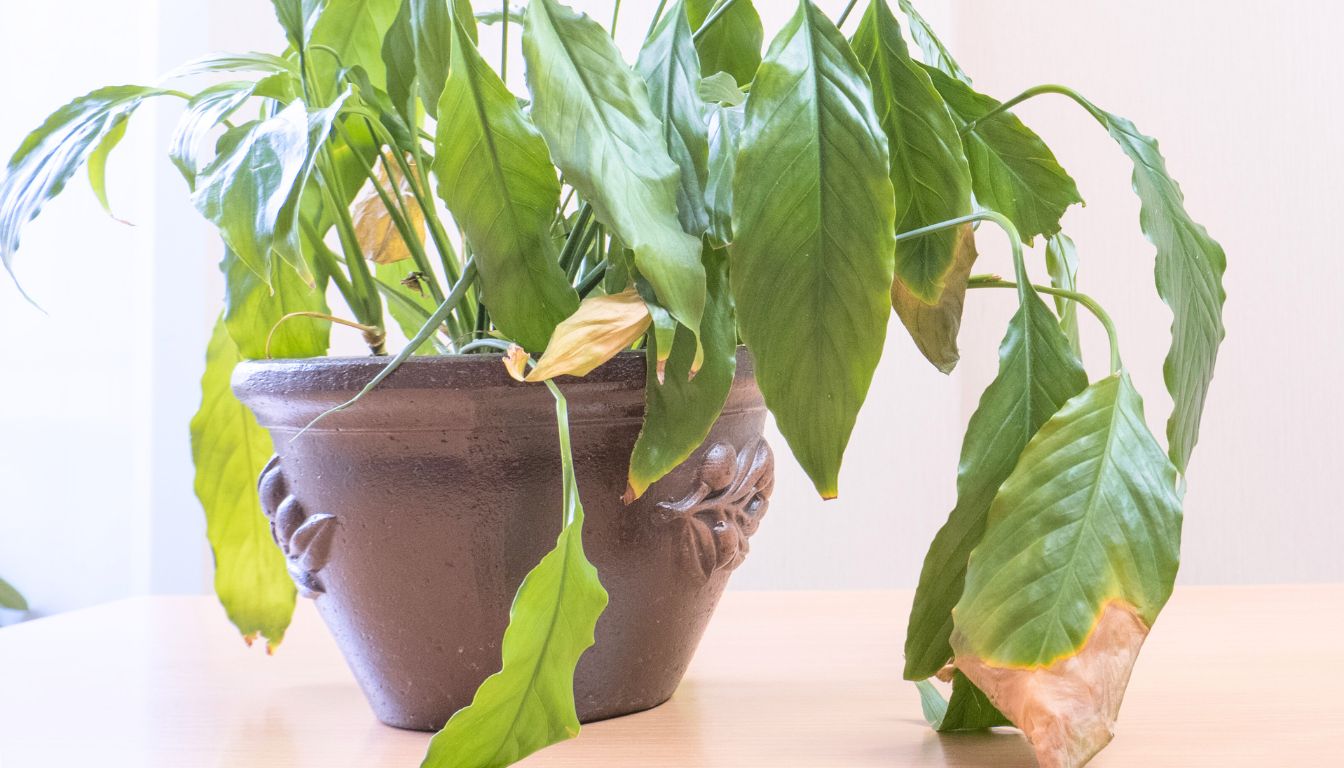
Once you have identified and found that your peace lily is overwatered, you need to start the treatment as soon as possible.
You might notice some other signs that indicate that your peace lily has received excess water. Let’s take a look at those first.
Signs of an overwatered Peace Lily
The following are the signs of an overwatered peace lily:
- Brown-edged leaves.
- Black-tipped roots with skimpy appearance.
- Leaves losing color and turning-yellow or brown
- Wilting and drooping of leaves
- Stunted growth
If your peace lily has these symptoms, your houseplant’s health is not in good shape at all. But don’t panic. By following a few steps, you can save your peace lily.
How to fix an overwatered Peace Lily?
Let’s look at the steps that will help you fix an overwatered peace lily.
- Stop watering: Water is a fundamental need for your plant. But if you are sure that your plant is overwatered, it doesn’t need more water for the time. Put a stop to watering for a few days, even if it wilts.
- Relocate it: If your peace lily is placed nearby a bright window, move it to a place with less light. It may sound weird in the first place, but the reason behind it is that your plant might already be stressed due to the excess water. You can reduce the stress by placing it in less light for some time.
- Cross-check the drainage: Containers need holes to pass excess water. Keeping a good number of drainage holes is the best thing for overwatered houseplants. If the pot lacks adequate drainage holes, you either need to replace the pot or add drainage holes with the help of a drill. These holes will help water to come pouring out of the pot.
- Provide space for air circulation: An overwatered peace lily plant needs air circulation in the root zone. Tilt the pot or roll it gently. It will shake up the soil and will create air pockets for air circulation.
- Use the right pot: If the pot is too big, repot your Peace lily. While repotting, remove all excess soil and shake the soil of the pot well. You can use a gentle spray to wash the soil from roots. Prune away any damaged roots. Add some fresh soil. You may use a commercial mix containing chunky bark pieces or some pine bark to create air pockets in the soil.
- Give it time to heal: If you have done everything you could for your diseased plant, wait patiently for a week to 10 days. You’ll see the signs of overwatering will cure soon. Resume fertilization only if you notice new growth.
Keep on checking your plant. After 2-3 days, if the new soil dries out, you can start watering again but keep a check on the amount of water.
Activated charcoal is good for the soil mix. It takes care of your peace lily root by protecting it from further infection and prevents root rot. Now let’s discuss root rot.
Root rot
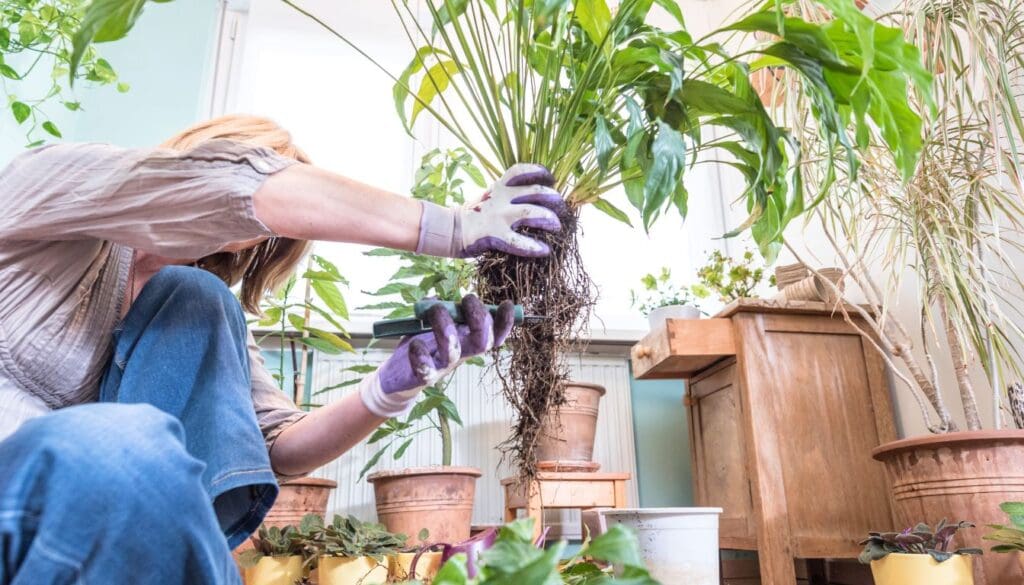
Root rot happens in the advanced stage of overwatering. Where the roots absorb extra water, it blocks oxygen flow and consequently gets damaged. When the roots get suffocated, they stop functioning and can’t supply the required nutrients to the plant.
After a few days, the plant becomes an easy victim to pest infestation and fungal diseases. Discoloration of the root happens, and they become brown and mushy. And finally, root rot happens.
If you fail to treat the root rot early, it may kill your beloved peace lily. You must identify the signs of overwatering and take necessary actions to save the plant.
Signs of root rot
Root rot has some signs. Let’s check them out.
- Discoloration of leaves
- Brown spots or brown leaves
- The stinking odor from the soil
- Curling and dropping leaves
- Mushy and smelly roots
- The roots turn brown, grey, or black.
How to save Peace lily from root rot?
For the treatment of diseased roots. Here are the steps recommended by experts:
Using the right soil mix for peace lily is one of the best ways to keep overwatering problems away from your plant. Apart from that, if you can use the below-mentioned steps wisely, you can rescue the peace lily that has undergone root rot.
1. Remove the damaged parts
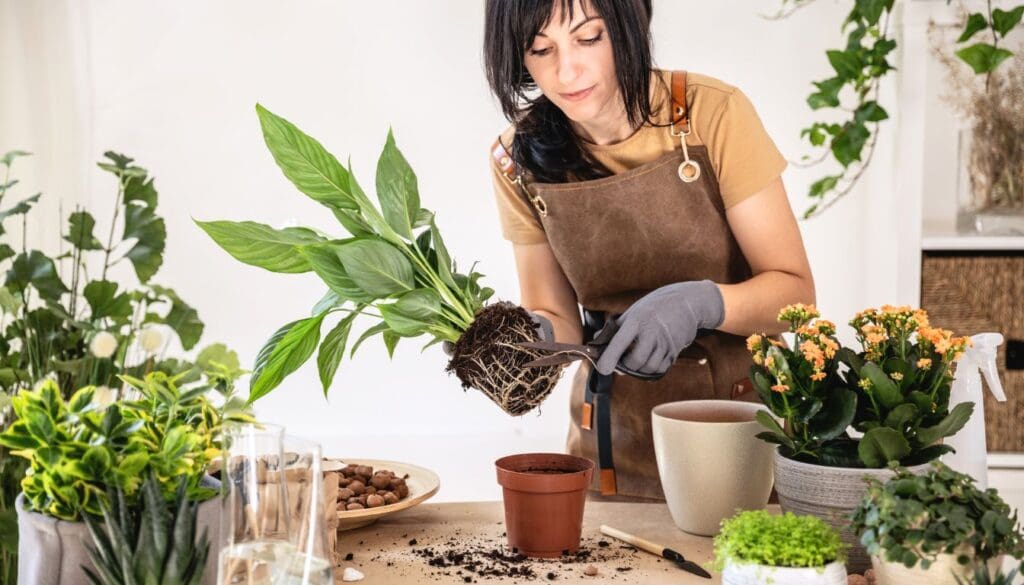
You will come across soft stems or discolored leaves on your peace lily, and you must get rid of these parts by removing them. If you don’t omit the affected parts, it will accelerate the spread of the disease.
Eliminate the roots that are already rotten. Take your peace lily out of its pot and wash the roots well to remove the soil. Eliminate all the roots that look brown and mushy.
Use a sharp and sterilized pruner to make clean cuts while pruning the roots and other damaged parts. Do not damage the healthy roots.
Disinfect the pruners after using them and discard the pruned parts to avoid the spread of further infections.
2. Repot and use new soil

As mentioned earlier, you must get a new pot for repotting your peace lily. The pot should have suitable drainage holes; otherwise, water-logging problems may occur again.
Prepare a fresh soil mix. The soil should be nutrient-rich and should contain the necessary minerals. The old soil can infect the plant again and will not let it recover. Try adding perlite or pumice to the soil mix and keep enough for draining.
Root rot is a danger to your lily, and it leads to fungal disease too.
When your peace lily’s health worsens due to the diseased root system, it becomes vulnerable to fungal attacks. Fungus manifest as root rot in houseplants in different ways. They include:
Cylindrocladium: The early signs of this attack include the yellowing and drooping of leaves. The petioles turn dark brown. The roots also turn black, mushy, and even may become peeled off.
Rhizoctonia: You can identify this fungus for its fine webbing and brown spots on the leaves. It usually affects the leaves, stems, and roots.
Phytophthora: You will notice small yellow leaves which start wilting. The tips of the roots turn from white to black, brown, or gray.
Pythium: All these diseases lead to rotting roots and may require lab tests to find the right one. Their symptoms occur with other signs of overwatering.
3. Aftercare
Once you notice signs of recovery and new growth, check the soil and start watering the peace lily to help it settle in properly. Neem oil is a good household remedy to prevent pest infestation or fungal attacks.
Place your houseplant in a medium bright spot, where it gets indirect sunlight. Do not expose the peace lily to direct sunlight, as it will cause sunburn. Do not fertilize the peace lily until it recovers totally.
How to check if the peace lily needs water?
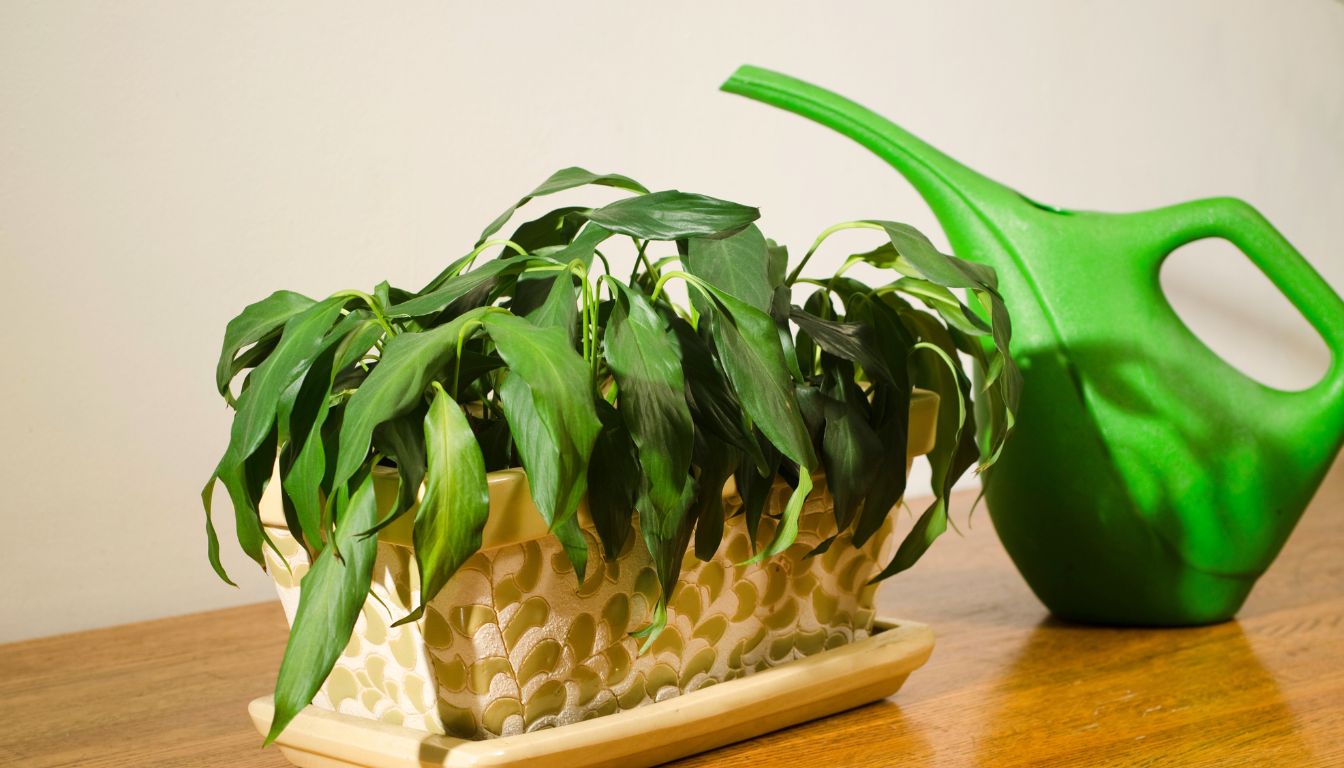
The easiest way is to check the soil is with your finger sticking into it. There are other ways to check the water requirement of your peace lily.
- Use a pencil or any stick to determine the water requirement of your plant. Dip it into the potting soil. When you bring it out of the soil and notice wet soil, it indicates that the soil has sufficient moisture. Hence it doesn’t need water anymore. But if it comes out dry and clean, water your peace lily.
- You can use this only if your peace lily pot is sitting in a clay or terracotta pot. Knock the wall of the pot a few times and hear the sound attentively. If it gives a hollow sound, water it without delay. If the sound is solid, the soil of Peace lily has enough moisture.
- Lift the pot you placed your peace lily in. Feel the weight of it. If it is light, the plant needs water. Keep in mind that the weight of a pot changes a lot when the substrate is wet.
- The easiest thing is to buy a moisture meter from any garden store. You can entirely rely on it to check the moisture requirement of the soil.
How to avoid overwatering the Peace Lily?

Prevention is better than cure. Make sure you do everything for your loved plant to avoid overwatering issues.
Check the soil first.
Before watering your plant:
- Check the soil carefully.
- Dip your finger about 2” down in the planter and check if it’s moist.
- If you find the soil is dark and damp, stop watering it.
Plants only need water if the soil is dry and light in color.
Instead of using fingers, you may get a soil moisture gauge or meter dedicatedly made for this task. It will do the guesswork of watering better!
Avoid watering the leaves.
Sometimes, you sprinkle water too often on your plant’s leaves. It is again another bad practice for your plant’s health because they can develop mold from it.
Ignore frequent watering of leaves. You should water the base of the plant so that the soil gets the water and sends it to the roots, and the plant can then absorb the water from its roots.
Water during the day.
Water in the day so that the moisture can evaporate easily. Watering at night keeps moisture in the soil for too long, which eventually encourages rot and fungus.
Keep a check on the drainage.
Drainage plays an important role and can make your plant overwatered if it is at fault. The pot needs to drain extra moisture; otherwise, it will remain in the soil, leading to root decay and other problems.
Provide bright indirect light.
Placing your peace lily plant in bright and indirect light allows the soil to get dry and excess water to evaporate faster. If you keep your peace lily in a low-light spot, you need to water accordingly or get overwatered.
If you remember these points, you will be able to avoid overwatering not only your peace lily but also other houseplants.
Also read: Do Peace Lilies Need Misting? (+Ideal Humidity)
Ref: ScienceDirect, NCBI, University of Vermont, Nationalgeographic, NC state university, University of Florida, The University of Arkansas, Queensland Government.
Recommended Garden Supplies
| Product Image | Our Recommended Gardening Supplies | Check Offers! |
|---|---|---|
Top Top
Top
Top
Top
Top
Top
Top
Top | rePotme Houseplant and Tropical Classic Potting Soil Mix | Check Offer On Amazon |
 Top
Top
Top
Top
Top
Top
Top
Top | Espoma Organic Indoor Plant Food | Check Offer On Amazon |
 Top
Top
Top
Top
Top
Top
Top
Top | GooingTop LED Grow Light 6000K Full Spectrum Clip Plant Growing Lamp | Check Offer On Amazon |
 Top
Top
Top
Top
Top
Top
Top
Top | Soil Moisture Meter | Check Offer On Amazon |
 Top
Top
Top
Top
Top
Top
Top
Top | Govee Hygrometer Thermometer, Bluetooth Enabled! | Check Offer On Amazon |
 Top
Top | LEVOIT Humidifiers for Large Room(Best For Plants) | Check Offer On Amazon |
 Top
Top
Top
Top
Top
Top
Top
Top | Upgraded DIY Automatic Drip Irrigation Kit, 15 Potted Houseplants Support | Check Offer On Amazon |
 Top
Top
Top
Top
Top
Top
Top
Top | Stainless Steel Heavy Duty Gardening Tool Set | Check Offer On Amazon |
 Top
Top
Top
Top
Top
Top
Top
Top | Bonide Insecticidal Soap | Check Offer On Amazon |
 Top
Top
Top
Top
Top
Top
Top
Top | Bonide 32 oz Spray Neem Oil for Organic Gardening | Check Offer On Amazon |
 Top
Top
Top
Top
Top
Top
Top
Top | Garden Safe Fungicide | Check Offer On Amazon |

